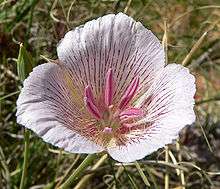Calochortus striatus
Calochortus striatus, known by the common name alkali mariposa lily, is a species of mariposa lily native to California and into Nevada.[4][5]
| Calochortus striatus | |
|---|---|
 | |
| Scientific classification | |
| Kingdom: | Plantae |
| Clade: | Tracheophytes |
| Clade: | Angiosperms |
| Clade: | Monocots |
| Order: | Liliales |
| Family: | Liliaceae |
| Genus: | Calochortus |
| Species: | C. striatus |
| Binomial name | |
| Calochortus striatus | |
| Synonyms[3] | |
|
Calochortus comosus A.Nelson | |
It is a vulnerable species on the California Native Plant Society Inventory of Rare and Endangered Plants.[6]
Distribution
It is primarily native to the Mojave Desert including its Antelope Valley region, and also has populations in the Kern River Valley and adjacent southern Sierra Nevada, Amargosa Desert, Owens Valley, Yosemite Valley, and eastern Transverse Ranges.[4][7][8] This is a plant of alkaline soils, usually in wetland-riparian areas, in Shadscale scrub and chaparral habitats.[5][9]
Description
Calochortus striatus erects a stem usually only a few centimeters tall but sometimes quite a bit taller, and a long basal leaf which may lie flat on the ground.[4]
At least halfway up the stem it may branch, and atop each branch is a bell-shaped lily bloom. Pointed sepals form the base of the flower and above are three rounded petals, which may be slightly toothed and 2−3 centimeters long. The petals are very light to very dark pink, lilac, or purplish with darker pink or purple veining or mottling.[4] The cup of the flower is somewhat hairy. The anthers are bright to dull pink, with pink pollen. The bulb blooms from April to June.
The capsule fruit is up to 5 centimeters long, producing flat seeds.[4]
See also
- Fish Slough Area of Critical Environmental Concern — habitat in the Owens Valley, Inyo County, California
References
- Parish, Samuel Bonsall 1902. Bulletin of the Southern California Academy of Sciences 1(9): 122
- Tropicos.org: Calochortus striatus Parish
- Kew World Checklist of Selected Plant Families
- Jepson: Calochortus striatus
- CalFlora: Calochortus striatus
- CNPS−California Native Plant Society Inventory of Rare and Endangered Plants: Calochortus striatus (alkali mariposa lily) . accessed 1.1.2016.
- CalFlora Distribution Map of Calochortus striatus
- Biota of North America Program 2014 county distribution map
- Flora of North America Program Vol. 26 Page 133 Calochortus striatus
External links
- CalFlora Database: Calochortus striatus (Alkali mariposa lily)
- Jepson Manual eFlora (TJM2) treatment of Calochortus striatus
- USDA Plants Profile of Calochortus striatus (alkali mariposa lily)
- U.C. Photos gallery: Calochortus striatus
| Wikimedia Commons has media related to Calochortus striatus. |